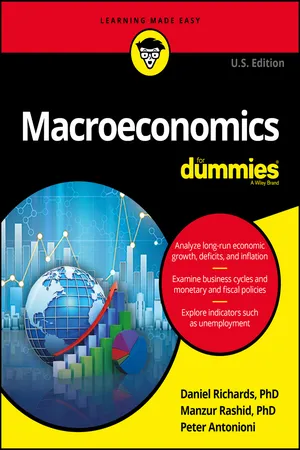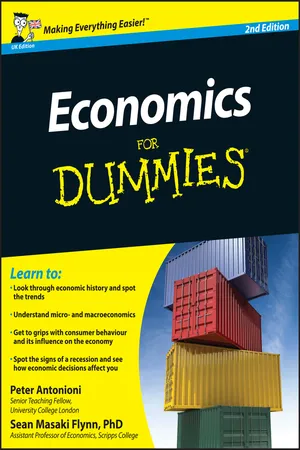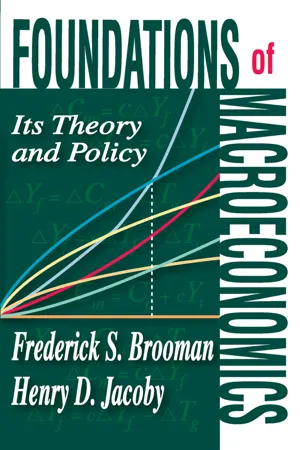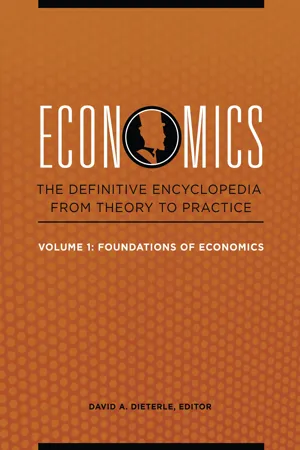Economics
Shifts in Short run Aggregate Supply
Shifts in short run aggregate supply refer to changes in the quantity of goods and services that firms are willing and able to supply at different price levels in the short term. These shifts can be caused by changes in input prices, productivity, or government regulations, and they impact the overall level of output and prices in the economy.
Written by Perlego with AI-assistance
Related key terms
Related key terms
1 of 4
Related key terms
1 of 3
7 Key excerpts on "Shifts in Short run Aggregate Supply"
- eBook - ePub
- Dan Richards, Manzur Rashid, Peter Antonioni(Authors)
- 2016(Publication Date)
- For Dummies(Publisher)
Chapter 10 for details). In the short run, the interaction of aggregate supply and aggregate demand determines how much a country produces (GDP) and how much on average those goods will cost to purchase (the price level), as well as how fast that price level is changing (inflation), plus how much unemployment an economy experiences.Looking at long-run aggregate supply
Economists distinguish between the short run and the long run because the economy behaves in a different way depending on the time frame you’re looking at. The important thing about the long run is that prices are fully flexible (they can change a lot), whereas in the short run prices are sticky (they don’t change by very much — check out the later section “Pulling apart why prices can be sticky ” for some suggested causes of this stickiness).Saying that prices are sticky is a way of saying something important about the behavior of suppliers. When demand for any product increases, the businesses that make those goods can do one of three things:- Hold output constant and raise their price until the extra demand is choked off
- Hold the price constant and increase supply enough to meet all the new demand
- Do a bit of both
The same options arise for the workers, who supply labor, and the capitalists who supply capital to the firms. In response to a rising demand for their services, they can supply more labor and capital services, raise their compensation demands, or, again, do some of both.In the long run, it’s the first option that best describes agents’ behavior in a macro sense. Given enough time, a rise in demand leads to a higher overall aggregate price level P (and higher wages, too) but no more output. In the short run, it’s the second choice that rules. Initially, prices and wages are held in check in response to a demand shock. The result is that, in the short run, a rise in demand evokes mostly an increase in production, whereas a fall in demand induces production to fall. In this section, we review briefly the long-run supply behavior, which is really what the growth model of Chapter 8 - No longer available |Learn more
Contemporary Economics
An Applications Approach
- Robert Carbaugh(Author)
- 2016(Publication Date)
- Routledge(Publisher)
- The model of aggregate demand and aggregate supply can be used to show how output and prices are determined in the short run. An economy is in equilibrium when aggregate demand equals aggregate supply.
- The aggregate demand curve shows the total amount of real output that buyers will purchase at alternative price levels during a given year. Movements along an aggregate demand curve are caused by changes in the price level of the economy. Shifts in the aggregate demand curve are caused by changes in non-price factors that affect household consumption expenditures, business investment, government expenditures, and net exports of goods and services.
- According to the multiplier effect, a change in any one of the components of aggregate demand (consumption, investment, government spending, or net exports) will have a magnified impact on national output and income. The size of the multiplier depends on the spending and saving habits of consumers and businesses.
- The aggregate supply curve shows the relationship between the level of prices and amount of real output that will be produced by the economy in a given year. The aggregate supply curve is horizontal when the economy is in deep recession or depression, upward-sloping when the economy approaches full employment, and vertical when the economy achieves full employment. Changes in factors such as resource prices, resource availability, and the level of technology will cause the aggregate supply curve to shift.
- The model of aggregate demand and aggregate supply can be applied to the problems of recession and inflation. According to this model, decreases in aggregate demand or aggregate supply can push the economy into recession; inflation may be the result of increases in aggregate demand or decreases in aggregate supply. An economy experiences “stagflation” when there is both recession and inflation.
- eBook - ePub
- Peter Antonioni, Sean Masaki Flynn(Authors)
- 2010(Publication Date)
- For Dummies(Publisher)
for long. At price level P Low , people want to buy Y Highworth of output. But that’s more than firms can produce at full employment. The only way to produce that much output is if employees work longer than the standard working week. The only way to get them to do so is to pay them more, and the only way to give them higher wages is for firms to raise prices. So with demand exceeding supply, prices are raised until they reachP * , at which price level the quantity demanded by consumers is exactly equal to the full-employment output level, Y * .As you can see, if prices have enough time to adjust, the economy always returns to producing at output level Y * . Because we’re calling the time required for prices to adjust the long run , it makes sense to call the vertical line above Y * the long-run aggregate supply curveA shock to the system: Adjusting to a shift in aggregate demand, because it shows how much output the economy will supply after prices have had enough time to adjust to equalise the supply and demand for goods and services. (For much more about supply and demand, see Chapter 8.)The previous section shows what happens if the prices of goods and services are, on the whole, too high or too low: they eventually adjust to the equilibrium price level (P * ) , and so the economy can get back to producing at the full-employment output level (Y * ). But what causes the prices to be too high or too low in the first place? The usual cause is a shock to aggregate demand – the total amount of goods and services that people are willing to buy.First, visualise what a shock to aggregate demand looks like: Figure 6-3 shows the aggregate demand curve shifting to the left from AD o to AD 1 . A leftward shift of aggregate demand is called a negative demand shock , and it may be caused, for example, by a decline in confidence in the economy that makes people want to save more and consume less. (A rightward shift of - eBook - ePub
Patentism Replacing Capitalism
A Prediction from Logical Economics
- Samuel Meng(Author)
- 2019(Publication Date)
- Palgrave Macmillan(Publisher)
3 .So far, we have assumed that the short-run AS is steeper than the long-run AS. The reasoning behind this assumption is that, due to the fixed capital or firm size in the short run, the cost of production in the short run increases faster than that in the long run. The other factor that needs to be taken into account is the input price. When the output level is high, the pressure on limited resources will drive up input prices and increase the long-run production cost sharply. However, firms are unable to perceive resource limits correctly in a timely fashion, so the slope of the short-run AS curve is unlikely to be affected by a future rise in input costs. This will create a situation where the slope of LRAS is greater than that of SRAS when production is approaching resource limits, shown as SRAS4 and SRAS5 in Fig. 4.31 .In this case, when a positive demand shock shifts the aggregate demand from AD4 to AD5 , the output level will increase to point G where AD5 intersects with SRAS4 . Here, the output can be greater than the resource limit can support, because we assume a soft resource limit, or a limit with a buffer. There is no economy operating at absolute resource limit, but when it is close to this limit (i.e. within the buffer zone), the extremely high price makes it very hard to go further to reach the absolute limit. The buffer zone can be viewed as a soft resource limit. Once the firm realizes the unexpected degree of the input prices hike and revises its production cost by including the factor of input price increases, the short-run supply curve shifts to SRAS5 and the output level falls back to the level supported by soft resource limits. It is worth mentioning that this explanation is similar to but actually different from the money illusion argument because there is no change in the money supply here.- 2. Business cycles and economic growth
- eBook - ePub
Foundations of Macroeconomics
Its Theory and Policy
- Frederick S. Brooman(Author)
- 2017(Publication Date)
- Routledge(Publisher)
3. Variations in Price and Money WagesThe intersection of the aggregate supply and demand curves indicates both the equilibrium level of physical output and (given the constant money wage w̄) the equilibrium level of prices. If an autonomous change in “real” demand occurs, it will shift the aggregate demand curve to intersect the aggregate supply curve at a new equilibrium position. Thus, in Figure 10.3 , an increase in real investment will raise the aggregate demand curve from d1 (Q,p) to d2 (Q,p); equilibrium moves from E1 to E2 , output rises from Q1 to Q2 , and prices increase from the level indicated by the slope of p1 to that indicated by the slope of p2 . As long as firms continue to offer their output at its supply price (i.e., w̄) MPL), their response to the increase in demand will be to attempt to produce more commodities and to raise their selling prices only when the expansion of output and employment reduces the marginal product of labor, making price increases necessary to meet the rising value of ‘w̄/MPL. The transition from the old equilibrium at E1 to the new one at E2 will then take the form of an upward movement along the aggregate supply curve.However, firms may react in a different way. Faced with excess demand equal to E1 T in money terms, they may begin by raising prices to the level that buyers seem willing to pay – namely, the price level p3 . The price rise will immediately create an incentive for firms to increase production, since the excess of price over marginal labor cost w̄/MPL shows that they will add to their profits if they hire more labor and expand output; but before the expansion can get under way, the situation may be made more complicated by the effects of the price increase on aggregate demand. If the “real” relationship between income and demand remains unchanged, the amount of money that buyers wish to spend will rise in the same proportion as the price level, and in money terms the excess demand will be still larger than before.11 On the other hand, the price increase will have set the redistribution effect to work, because with money wages constant, real wages have fallen; at the original level of output Q1 , both total real wages and the “wage share” in income will be reduced in proportion to the rise in prices, causing a fall in real consumption to the extent that the wage earners’ MPC exceeds the MPC of profit recipients.12 - eBook - ePub
Economics
The Definitive Encyclopedia from Theory to Practice [4 volumes]
- David A. Dieterle, David A. Dieterle, David A. Dieterle(Authors)
- 2017(Publication Date)
- Greenwood(Publisher)
Figure 2. Short-run and long-run aggregate supply curvesMany economists believe that the best way to combat stagflation is to wait until the prices of the factors of production adjust back down or the disruption in the supply chain is remedied. Conversely, if there is a decrease in the prices of the factors of production or if producers expect lower inflation in the future, SRAS will increase (more suppliers will enter the market) because it is cheaper to produce, which results in a decrease in the overall price level and a short-run increase in real GDP.The central bank and the government can attempt to increase AS, which would result in lowering the overall price level and increasing real GDP. The central bank can implement monetary policy in an attempt to increase AS by increasing the money supply and lowering key interest rates. Changes in key interest rates will impact other interest rates, which will impact investment spending. As interest rates decrease, producers have an incentive to borrow money and purchase new capital, which will be used to produce future goods and services (this is an increase in the factors of production of an economic system). Additionally, the government can attempt to increase AS through fiscal policy by lowering taxes for producers or by providing direct payments in the form of grants or low-interest loans for creating new capital investments. Both these monetary and fiscal policies are based on the belief that as producers are more willing to produce more goods and services, they will hire more workers—and this increased wealth of the producers will result in increased income levels for households to purchase more goods and services.As long as producers use their decreases in taxes or direct payments for sound capital investments, AS will increase. The economic and political debate surrounding these ideas is that producers will use their decreases in taxes not to purchase new capital investments but to further their own personal wealth. Additionally, some believe government induces producers to make poor investments in capital that does not yield an increase in AS, resulting in a loss of tax-payer money. - eBook - ePub
A Primer on Macroeconomics
Policies and Perspectives
- Thomas M. Beveridge(Author)
- 2018(Publication Date)
- Business Expert Press(Publisher)
their jobs, put in a bit more effort. This is a temporary phenomenon—once normality returns, workers ease off once more.Expectations about Inflation:Macroeconomic Equilibrium: Balance in the Short Run Reaching Short-Run EquilibriumWe have concluded that changes in resource costs affect the position of the SRAS curve. But, one step back, expectations about inflation influence resource costs. If workers expect the inflation rate to be zero, then they ought to be content with their current wage settlement. However, if they believe the inflation rate will rise to 7 percent, then (even though this belief is mistaken!) they will feel justified in asking for a wage hike of 7 percent that will increase per-unit costs, decrease profits, and push the SRAS curve to the left. Similarly, if employers’ expectations regarding future prices change, for example, a new expectation of rising prices, then firms will anticipate higher wage claims and rising costs, and, in response, they will decrease output at any given price level—the SRAS curve will shift to the left. On the other hand, if there is a downward adjustment in expected inflation rates, then the SRAS curve will shift to the right.In this section, we examine how the macroeconomy achieves short-run equilibrium. Considering Figure 5.11 , we have done enough economics by this point to realize that initial equilibrium occurs where the two curves, AD1 and SRAS1 , intersect, at an aggregate price level of P* and an output level of y*. However, it is worthwhile to trace through the process by which the economy achieves that equilibrium.To analyze the equilibrating process, let us suppose that the AD curve initially is at AD0 , and that the equilibrium price and output are P0 and y0 , respectively. Now aggregate demand increases from AD0 to AD1
Index pages curate the most relevant extracts from our library of academic textbooks. They’ve been created using an in-house natural language model (NLM), each adding context and meaning to key research topics.
Explore more topic indexes
Explore more topic indexes
1 of 6
Explore more topic indexes
1 of 4






